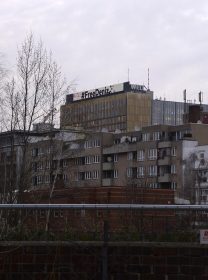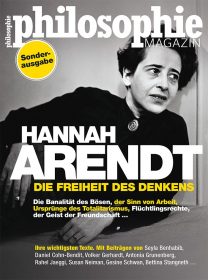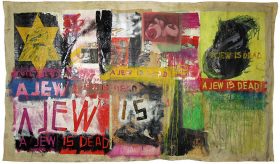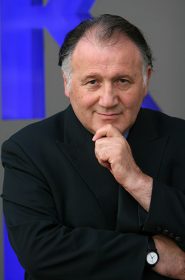
View from the Academy of the Jewish Museum Berlin towards the Springer building with the lit-up sign, #FreeDeniz; Jewish Museum Berlin, photo: Stefanie Haupt
As I leave my office at the Jewish Museum Berlin, emerging from the W. Michael Blumenthal Academy onto the street, the hashtag “#FreeDeniz” beams towards me from an illuminated black-on-turquoise-green display on the Axel Springer building. The first time I saw it, I was cheered by the signal that the publishing house Axel Springer SE* was calling for the release of Die Welt’s correspondent in Turkey, Deniz Yücel. But each day seeing the display has gotten sadder. I’ve known Deniz Yücel since 2003, when — together with other German- and Turkish-speaking Berliners — he organized bilingual protests against the bomb attacks on the two Istanbul synagogues, Neve Shalom and Beth Israel, on November 15 of that year. Twenty-four people were killed in those attacks and at least 300 wounded.
Deniz and I haven’t had contact for quite awhile. But since mid-February, through the news of his imprisonment for “terrorist propaganda” and the car procession protests that followed it, as well as conversations with friends and of course the illuminated sign, memories from the period in 2003 and 2004 when we interacted almost weekly having been coming back. → continue reading
 “Something happened there to which we cannot reconcile ourselves. None of us ever can,” said Hannah Arendt with regard to Auschwitz and its repercussions during a now legendary TV interview with Günter Gaus. A two-minute excerpt from that encounter serves today in our permanent exhibition as introduction to a film installation concerning the Auschwitz Trial (cf. this blog entry about the reopening of that part of the exhibition in summer 2013).
“Something happened there to which we cannot reconcile ourselves. None of us ever can,” said Hannah Arendt with regard to Auschwitz and its repercussions during a now legendary TV interview with Günter Gaus. A two-minute excerpt from that encounter serves today in our permanent exhibition as introduction to a film installation concerning the Auschwitz Trial (cf. this blog entry about the reopening of that part of the exhibition in summer 2013).
In our exhibition of the work of Fred Stein in 2013/14 we presented photographs inter alia of the political theorist Arendt herself, as you can read in our blog and on the exhibition website.
Hannah Arendt is a major influence also on contemporary artists: Alex Martinis Roe, in the work she produced for our art vending machine, “A Letter to Deutsche Post,” demanded a re-issue of the postage stamps bearing Arendt’s portrait (cf. our interview with the artist in this blog). Also, a symposium held at our museum last December drew on the work of Hannah Arendt as a springboard for discussion of the current significance of pluralism in theory and practice (cf. the topics addressed there, as listed in our events calendar).
Philosophie Magazin has just devoted a special issue to this exceptional thinker. Titled Hannah Arendt. Die Freiheit des Denkens [Hannah Arendt. The Freedom of Thought], on the newsstands as of 16 June. → continue reading
A Conversation with Peter Weibel about whether Boris Lurie Should Be Seen as a Part of the Ultra-realist Neo-avant-garde, and Pornography as a Metaphor for Capitalist Society

Boris Lurie, “A Jew is dead,” 1964; Boris Lurie Art Foundation, New York, USA
Mirjam Bitter, blog editor: As part of the program accompanying our Boris Lurie retrospective, you’ll be giving a lecture at the Jewish Museum Berlin on 30 May 2016 on the subject of “The Holocaust and the Problem of Visual Representation,” (further details of which can be found in our events calendar). Is this tied up with the idea that the Holocaust is a major theme in Lurie’s work?

Peter Weibel
© ONUK
Peter Weibel: The Holocaust, along with war, Hiroshima, and Nagasaki were pivotal traumatic experiences for the post-Second World War neo-avant-garde. Take, for example, Yves Klein’s painting “Hiroshima” (1961) or Joseph Beuy’s environment “Show Your Wound” (1974–1975). Many artists responded to the inhumanity they had witnessed by calling into question humanity and indeed, civilization itself: Why, they asked, had literature, painting, music, and philosophy been unable to prevent this twentieth-century barbarism? → continue reading



